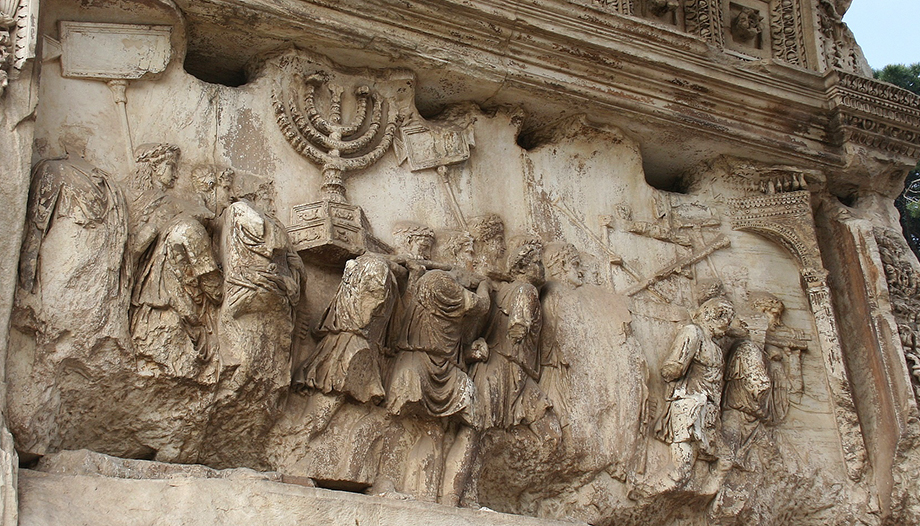




















Israel. Palestine. Ha-Aretz (Hebrew: the Land tout court, which is how the Jews define the Land God promised them, from Dan in the north to Beersheba in the south). Filastìn (Arabic: Palestine). Yerushalayim (Hebrew name for Jerusalem, meaning "hill of peace" and, by extension, city of peace). Al-Quds (the Holy One: Arabic name for Jerusalem). In this small handkerchief of land, things often have two or more names, and the definitions of the places in this tiny region straddling Africa and Asia are emphatic, giving a sense of the absolute, of the divine, almost as if all the sights of the world, all the expectations, longings and desires of billions of men throughout history converge here.
Therefore, before delving into the Arab-Israeli question, it is necessary to clarify to whom and to what we are referring. To be even more precise, it would even be necessary to speak first of all of a Jewish questionwhich then becomes Judeo-Ottoman and at the same time Judeo-Arabic o judeo-palestineand, finally, only since 1948, Arab-Israeli o israeli-palestinian.
Jews or Israelis?
Let us begin with one of those assumptions that every novice Orientalist should be aware of. Just as one learns, during one's first lessons at university, that not all Arabs are Muslims and not all Muslims are Arabs, it is necessary to point out that not all Jews are Israelis and not all Israelis are Jews.
So who are the Israelis? They are the citizens of the State of Israel, a West Asian country of about 9 million inhabitants, of whom about 7 million are Jews, with a considerable minority (about 2 million) of Arabs, overwhelmingly Sunni Muslims, but with a small minority of Christians and Druze. Israelis, therefore, are both Jews and Arabs (or Palestinians: on the use of the latter term we refer to the following pages) and both Jews and Muslims, Druze, Christians, etc.
The Jews (a term that is synonymous, in Italian, with "Israelites" and not "Israelis"), for their part, are an ethno-religious group numbering between 17 and 20 million people, most of whom (about 10 million) reside in the United States; there are also about 7 million in Israel. There is also a fairly significant presence in France (there were 700,000 at the beginning of this century, but they are steadily decreasing), the United Kingdom, Russia and other countries. In Italy there are about 45,000 Jews.
They define themselves as an "ethno-religious group", and not simply as followers of a religion, because the concept of ethnicity and religious faith, in Judaism, are closely related. Before the ShoahIn the Holocaust, the genocide that exterminated most of the Jewish communities in Europe, the Old Continent was the cradle of more than half of the world's Jews.
Ashkenazi and Sephardic
Jews, both those living in Israel and those scattered throughout the world, are generally divided into two large groups, based on different factors, which are, first of all, all the cultural aspects that distinguish them, such as language, traditions, customs and habits, as well as the historical vicissitudes through which they have passed and the geographical situation of the community to which they belong.
These two groups are called "Ashkenazi" and "Sephardic" (from Ashkenaz and Sepharad, which in medieval Hebrew mean Germany and Spain respectively).
In general, the Sephardim are those Israelites (Isaac Abravanel, Jew and Minister of Finance of the Kingdom until the expulsion, speaks of between 200,000 and 300,000) who refused to convert to Christianity and were expelled from Spain in 1492, after the definitive Reconquest of the country from the Moors by Ferdinand, King of Aragon, and Isabella, Queen of Castile. They found refuge in North Africa, in the Ottoman Empire, in Egypt, in the Middle East.
However, nowadays the Jewish communities of Yemen, Iraq, Palestine and other countries of Asia and Africa, which have little or nothing to do with the refugees expelled in the 15th century from the Iberian Peninsula, are also defined as Sephardic. This is because, in the 16th century, a scholar and mystic of Andalusian origin, Yossef Caro (1488-1575), wrote a code, called the Shulhan Arukh, which collected all the traditions, customs, rules of lawfulness and unlawfulness and rituals of the Hispanic communities.
In response, a Polish Jewish scholar, Moshe Isserles, also known as Harema, commented on Caro's code, ruling that some of the rules contained therein did not conform to Ashkenazic tradition. This created the distinction between Ashkenazim and Sephardim (a difference ranging from rituals to food, to the way of relating to non-Jews, to the language used in daily life, etc.), which many also refer to as European Jews and Oriental Jews, respectively.
What we have just expressed is no more than a generalization of the many and varied differences among Jews throughout the world, who, in spite of everything, have always preserved their common roots, worship and, above all, the nostalgic longing for the return to the Promised Land, accompanied by the pain of exile (components, the latter, omnipresent in gestures and words of daily life and the most important celebrations).
Diaspora
The Diaspora, that is, the dispersion of the Israelites (a term that is synonymous with 'Jew' and not 'Israelite') throughout the four corners of the globe had already begun between 597 and 587 B.C., with the so-called 'Babylonian Captivity', that is, the deportation of the inhabitants of the kingdoms of Israel and Judah to Assyria and Babylon, and with the destruction of the temple built by Solomon, at the hands of King Nebuchadnezzar.
In 538, with the Edict of Cyrus, king of the Persians, part of the Jews were able to rebuild the temple on their return home, although many Jews remained in Babylon or went to live in other regions, a process that continued in the Hellenistic and Roman eras.
It was Rome, however, that put an end - and for almost two thousand years - to the national and territorial aspirations of the Jewish people, with the bloody three Jewish Wars. The first of these (66-73 A.D.), initiated by a series of revolts of the local population against Roman authority, culminated in the destruction of Jerusalem and the Temple, as well as other cities and military strongholds such as Masada, and the death, according to the historian of the time Josephus Flavius, of more than a million Jews and twenty thousand Romans. The second (115-117) took place in the Roman cities of the Diaspora and also claimed thousands of victims. In the third (132-135), also known as the Bar-Kokhba revoltThe Roman war machine steamrolled like a steamroller over everything in its path, razing some 50 cities (including what was left of Jerusalem) and 1,000 villages. Not only the rebels, but almost the entire Jewish population that had survived the First Jewish War was annihilated (there were some 600,000 dead), along with the very idea of a Jewish presence in the region, which was Romanized even in its topography. In fact, the name Palestine, and more specifically Syria Palæstinawas given by Emperor Hadrian to the ancient province of Judea in 135 A.D., after the end of the Third Jewish War (Palestine proper was, until then, a thin strip of land, roughly corresponding to today's Gaza Strip, in which the ancient Philistine Pentapolis was located).
The same emperor had Jerusalem rebuilt as a pagan city, under the name of Aelia CapitolinaThe Jewish people, placing temples to Greco-Roman divinities just above the Jewish and Christian holy places (Jews and Christians were then assimilated), and prevented the entry to any Jew, although, at least during the first centuries of the Christian era, a Jewish minority survived in the countryside of Judea and especially in the holy cities of Safed and Tiberias, in Galilee, A Jewish minority survived in the Judean countryside and especially in the holy cities of Safed and Tiberias, in Galilee. So much so that it appears in the chronicles of the time that, during the revolt against the Byzantine emperor Heraclius in 614, the Israelite minority participated in massacres of Christians (about 90,000 dead) and in the destruction of the Jewish holy places.000 dead) and in the destruction of some holy places such as the Holy SepulcherHe even ruled Jerusalem for 15 years before it was almost completely massacred in turn and favored the advance and conquest of the Arab-Islamic troops in 637.
One wonders, in any case, why there was not, before 1880, the date that traditionally marks the beginning of the Arab-Israeli question - at this time it would be more correct to call it still Jewish-Palestinian - a massive immigration of Jews to the region, which in the meantime had passed from hand to hand: Romans, Persians, Byzantines, Arabs, Crusaders, Ottoman Turks.
Certainly for economic reasons (the Jewish communities, already highly urbanized and engaged in trade, had settled permanently in many important centers of Mediterranean Europe, Asia and Africa and had woven a dense commercial network), but probably also religious: the Babylonian Talmud, in fact (tractate Ketubot, 111a), states that God would prevent the Israelites from rebelling against the nations by creating their own State; from immigrating en masse to the Holy Land; from hastening the arrival of the Messiah. These prohibitions form the basis of the rigidly anti-Zionist and anti-Israel doctrine of the Neturei Karta (Guardians of the City, an extremist Jewish group living today mainly in two Jerusalem neighborhoods, Me'ah She'arim and Ge'ula), an Orthodox Jewish movement that refuses to recognize the authority and very existence of the State of Israel.
In any case, at the end of the 19th century, Palestine was part of the largest province (vilayet) of Syria and its population was almost exclusively Arabic and Islamic-speaking (although there were significant Christian minorities, especially in cities such as Nazareth, Bethlehem and Jerusalem itself, where Christians sometimes represented a relative majority). There were only 24,000 Jews, 4.8% of the population.
As Ottoman subjects, they were considered (like Christians) second-class citizens, that is, dhimmiand were subject to the payment of a capitulation tax, called a capitulation tax. jizyaand a tax on the land they owned, kharàjuntil 1839, when, after the Edict (Hatti sherif) of Gülhane followed by the Edict (Hatti) Hümayun (1856) and the Islahat Fermani, Sultan Abdülmecit I granted full legal equality with Muslims to all non-Islamic subjects of the Sublime Porte, within the framework of the famous TanzimatThe reforms, liberal reforms of European inspiration.
Paradoxically, the germs of the Arab-Israeli question came to light at the very moment when, at the time of the liberal revolutions and the opening of the ghettos in Europe and the Middle East, the Arab-Israeli question was being raised. Tanzimat In the Ottoman Empire, violent pogroms and more subtle acts and episodes of anti-Semitism continued to occur, especially in Europe and Russia, but also in Syria and other parts of the Western and Eastern world.
It was then, in the context of European nationalism and also as a consequence of the Haskalah, the Jewish Enlightenment (which saw the rebirth of Jewish-European literature and culture), that the ideology that forms the basis of the current State of Israel was born and developed: Zionism.
Writer, historian and expert on Middle Eastern history, politics and culture.












